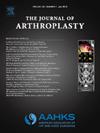采用直接前路或后路同时进行双侧全髋关节置换术:倾向得分匹配研究
IF 3.4
2区 医学
Q1 ORTHOPEDICS
引用次数: 0
摘要
导言:在因髋关节疼痛就诊的患者中,约有 20% 患有明显的双侧髋关节骨关节炎,在接受全髋关节置换术 (THA) 的患者中,有 22% 最终需要进行对侧 THA。同步双侧髋关节置换术(SBTHA)与分期双侧髋关节置换术的风险和益处已得到充分研究,其安全性与单侧和SBTHA相当。然而,SBTHA 的手术方式对术后结果的影响仍不清楚。我们试图比较直接前路(DAA)和后路(PA)两种手术方式在接受 SBTHA 患者中的围手术期预后和并发症发生率:我们根据年龄、性别和体重指数(BMI)进行了1:1倾向得分匹配。方法:我们根据年龄、性别和体重指数(BMI)进行了 1:1 的倾向得分匹配,匹配后共有 252 例患者,其中 126 例为 DAA 组,126 例为 PA 组。对每组患者的围手术期结果和最近一次随访时的手术并发症进行了回顾性收集。平均随访时间为 36.7 个月(12.5 至 74.4 个月):结果:与PA相比,使用DAA的SBTHA手术时间(P < 0.001)、麻醉时间(P < 0.001)和住院时间(P < 0.001)均明显缩短。与 PA 组(57%)相比,DAA 组患者出院回家的比例更高(91%)(P < 0.001)。不同手术方式的院内并发症(P = 0.617)、90 天并发症(P = 0.605)或再次手术率(P = 0.309)均无差异:结论:无论是通过 DAA 还是 PA,SBTHA 都可以安全进行,并发症发生率较低。结论:无论是通过 DAA 还是 PA,SBTHA 都能安全进行,且并发症发生率较低。在 SBTHA 的情况下,DAA 可缩短手术时间,缩短住院时间,提高患者出院回家的比例。本文章由计算机程序翻译,如有差异,请以英文原文为准。
Simultaneous Bilateral Total Hip Arthroplasty With Either the Direct Anterior or Posterior Approaches: A Propensity Score Match Study
Background
Bilateral hip osteoarthritis is evident in approximately 20% of patients who present to the clinic for evaluation of hip pain, and for those undergoing total hip arthroplasty (THA), 22% will end up needing a contralateral THA. The risk and benefits of simultaneous bilateral total hip arthroplasty (SBTHA) versus staged bilateral THA procedures have been well studied, demonstrating equivalent safety profiles comparable to unilateral and SBTHA. However, the influence of the surgical approach on SBTHA on postoperative outcomes remains unclear. We sought to compare perioperative outcomes and complication rates between the direct anterior approach (DAA) and posterior approach (PA) in patients undergoing SBTHA.
Methods
We performed a 1:1 propensity score match based on age, sex, and body mass index. A total of 252 patients were available after matching, 126 patients in the DAA group and 126 in the PA group. Perioperative outcomes as well as surgical complications at the latest follow-up were retrospectively collected for each group. The mean follow-up was 36.7 months (range, 12.5 to 74.4).
Results
A SBTHA with DAA had significantly shorter surgical time (P < 0.001), anesthesia time (P < 0.001), and length of stay (P < 0.001), compared to the PA. A greater percentage of patients in the DAA group (91%) were discharged home compared to the PA group (57%) (P < 0.001). There were no differences in in-hospital complications (P = 0.617), 90-day complications (P = 0.605), or reoperation rates (P = 0.309) between surgical approaches.
Conclusions
A SBTHA, either through the DAA or PA, can be safely performed with low complication rates. The DAA in the setting of SBTHA provides shorter surgical times, a shorter length of stay, and a greater percentage of patients discharged home.
求助全文
通过发布文献求助,成功后即可免费获取论文全文。
去求助
来源期刊

Journal of Arthroplasty
医学-整形外科
CiteScore
7.00
自引率
20.00%
发文量
734
审稿时长
48 days
期刊介绍:
The Journal of Arthroplasty brings together the clinical and scientific foundations for joint replacement. This peer-reviewed journal publishes original research and manuscripts of the highest quality from all areas relating to joint replacement or the treatment of its complications, including those dealing with clinical series and experience, prosthetic design, biomechanics, biomaterials, metallurgy, biologic response to arthroplasty materials in vivo and in vitro.
 求助内容:
求助内容: 应助结果提醒方式:
应助结果提醒方式:


